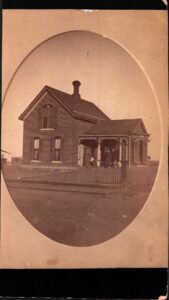by Kristine Schmucker, HCHM Curator
In 1927, a group of twenty-four women posed in front of the home of Mrs. J.W. Inghram at 205 Allison Street in Newton. Many of these women had been active in the last decade and a half promoting community causes including women’s suffrage.
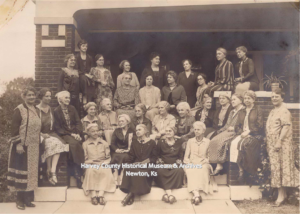
First row (front) left to right – Mrs. O. B. Hildreth ( Mary), Miss Kate Murphy, Mrs. Fox Winne (Mary), Mrs. A. R. Glazier (Adelaide), Mrs. A. B. Gilbert (Lovina).
Second row, left to right – Mrs. J. W. Inghram (Jennie), Mrs. J. B. Heffelfinger (Lucile), Mrs. J. T. Ray (Hannah), Mrs. Clarence Spooner (Mary), Mrs. F. L. Abbey (Florence), Mrs. J. C. Mack (Elizabeth), Mrs. A. H. Morrison (Cora), Mrs. J. W. Patterson (Eva), Mrs. Emma Smolt, Mrs. Bernard Warkentin (Mina), Mrs. E. G. Hudson (Virginia), Mrs. John Reese (Harriet), Mrs. H. B. Lantz.
Third row, seated – Mrs. D. H. Switzer (Fannie), Mrs. Ray Guy (Emma), Mrs. J. C. Nicholson (Lottie Hart), Mrs. W. R. Murphy (Sarah), Mrs. R. A. Goerz (Martha), Mrs. J. T. Axtell (Lucena).
Fourth row, standing – Mrs. W. C. Plummer (Hattie), Mrs. Oscar Nelson (Ethel) [?], Mrs. J. L. Napier (Flora), Mrs. Oscar Nelson (Ethel) [?], Mrs. A. O. Haury (Hermina), Mrs. L. T. Smith (Edith).
They were all members of the
Ladies Reading Circle a women’s club that had started in 1880.
Ray’s Tea Room, Women’s Suffrage & the Ladies Reading Circle
The ladies of the Reading Circle were involved in many community activities and causes. Several were also active in women’s suffrage.
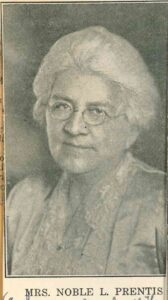
Carolina (Mrs. Noble L.) Prentis.
In October 1912, over 100 ladies from Harvey County gathered at the Methodist Church to hear Mrs. Noble L. Prentis discuss women’s suffrage. She noted:
“the amendment will carry if the women want it. . . It is up to the women to arouse from an indifferent state and show that the ballot needs her. Not so much in questions of political matters, not for finance or tariff, but on the great moral questions of the day.”
She gave several examples of “great moral questions” including “white slave traffic,” “better wage earning laws,” and prohibition which had “thousands of dollars as a fund to back them up in the work to agitate the question of re-submission of the prohibitory law.”
Mrs. Prentis concluded stating: “If the ballot is given to women, that will put an end to any attempt to resubmit that law to the voters of the state.”
Following the speech, Mrs. Ella Welsh presided over a meeting organizing volunteers to assist in polling different section of the city. A central meeting place was also need and it was reported that Mr. Ray had “kindly offered a space” for suffrage headquarters at Ray’s Tea & Coffee House at 506 Main, Newton. (Evening Kansan Republican 14 October 1912) James Ray’s wife, Hannah, was active in the Ladies Reading Circle and several other women’s groups and no doubt influenced the decision to make the space available.
During the early 1900s, tea rooms had become a popular way for women to gather in public. The Tea Room, often a store front operated by a woman, was one of the first acceptable places for women to eat in public alone. Typically, the shops would be decorated for home-like comfort, and like for the Suffrage Movement, Tea Rooms were often the headquarters for various community projects.
Ray’s Tea Room was likely run by Hannah Ray as a store front with her husband’s grocery business in the rest of the building.
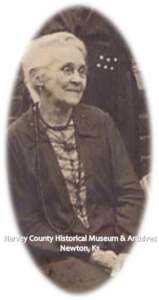
Hannah Hurst Ray, 1927.
One of the women in the crowd that October evening was Mrs. Prentis’ daughter, Elizabeth Prentis Mack.
Elizabeth inherited her parents passion for writing and reporting as the daughter of famed Kansas newspaper editor, Noble L. Prentis. Lizzie, as she was more often called, was born in Clark County Missouri on April 14, 1870. In 1887, the Prentis family moved to Newton, Kansas.
NHS Class of 1888
Lizzie made her mark early. For Kansas Day in 1888 she played the organ while a “select choir” sang “The Song of the Kansas Emigrant.” She later presented “Kansas Men” and overview of Kansas statesmen, including Gov Charles Robinson, and “literary lights” like Wilder.
At the same Kansas Day, a classmate, Hattie Hildreth spoke of “Kansas Women” during which she
“begged her hearers to remember that the first school superintendent in Harvey county was a woman; that the first school bonds in Darlington township were voted by women, and women would carry the bonds to build new schools houses in Newton; that more girls than boys had graduated in the Newton High school, and that the first baby toted through the streets of Newton by fond parents was a girl.” (Weekly Republican 3 February 1888)
Harvey County seemed progressive indeed.
In May, both Hattie Hildreth and Lizzie Prentis were two of ten students in the third class to graduate from Newton High School in 1888. The class included another talented member, Anna A. Perkins who, along with Cena Axtell, graduated from the College of Physicians & Surgeons in Kansas City in 1897.

These women carried their civic spirit with them to adulthood and were involved in various groups including the Women’s Christian Temperance Union (W.C.T.U.) which was also involved in suffrage.
At the 1915 meeting of the W.C.T.U. in Newton a new yell was composed.
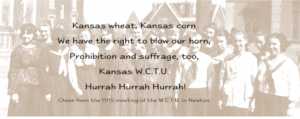
Throughout her life Lizzie found ways to contribute to the community by involvement in club like the W.C.T.U. and church activities at the Congregational Church.
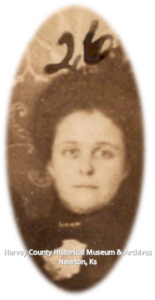
Elizabeth Prentis Mack, ca 1896-99
Married Life
In 1892, Lizzie married John C. Mack a rural school teacher.
For a short time, John worked as postmaster at Hesston, Ks where the newlyweds lived for several years. In 1895, a son, Noble Prentis Mack, named for his grandfather, was born.
In 1896 J.C. Mack joined with others and purchased interests in the Kansan. The Kansan Printing Company was incorporated in 1907 with J. C. Mack in a leadership role. In 1928, “he completed the handsome building . . .now the home of the company” the Kansan Printing Company.
In 1899, tragedy struck when their only child, Noble Prentis Mack, died just days before his fourth birthday. Described as:
“more than an ordinary child. He was a favorite in the office and his bright sayings and winning ways made his visits always welcome. . . . his presence was a ray of sunshine.” (Newton Kansan, 2 June 1899)
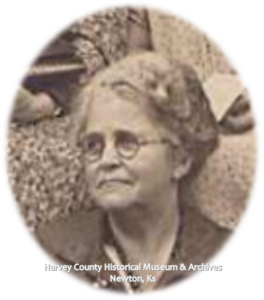
Elizabeth Prentis Mack, 1927
“His Passing Leaves a Void Deepest & Most Intimate”
January 29, 1930, J.C. Mack died of a stroke. J. C. Mack was praised as “public-spirited and liberal citizen” that “gave his time, and energy and his rare practical judgement to this city and county and state freely.”
The author of his obituary, probably Mrs. Lizzie Mack, noted;
“John Mack was a good man, a true friend, a genial companion, a square partner, a thoughtful, attentive husband . . . his passing leaves a void deepest and most intimate, save the heart of the home companion of his mature life among those in the newspaper office, to whom he affectionately referred to as “my family.”
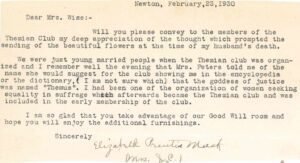
Elizabeth Prentis Mack to Themian Club, Newton, 23 February 1930.
Evening Kansan Republican
Following the death of her husband, Mrs. Lizzie Mack stepped into the role of General Manager for the Evening Kansan Republican, continuing the tradition of her parents, Mr. & Mrs. Noble L. Prentis and her husband, John C. Mack. She assumed the responsibility of business management, editorial policy and general supervision of the company. Under her leadership, the newspaper was able to continue to operate during the difficult Depression years and through the Second World War.
In 1948, Lizzie suffered a stroke and by July 1949 she had taken an apartment at the Ripley Hotel due to failing eye sight. Her health continued to decline and in July 1950 she moved to the hospital and received care there until her death on February 1, 1951.
Her obituary concluded with the note that “for many years she was a leading spirit and hard worker.” Her steady, behind the scenes influence, first in various women’s organizations and then as the manager of the Evening Kansan Republican cannot be measured.



